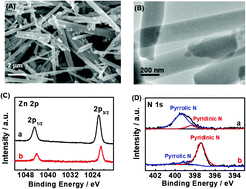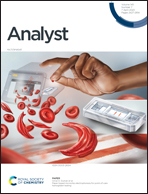A robust and efficient aqueous electrochemiluminescence emitter constructed by sulfonate porphyrin-based metal–organic frameworks and its application in ascorbic acid detection†
Abstract
The robust and strong electrochemiluminescence (ECL) emission of organic emitters in an aqueous solution is crucial for expanding their applications in early diagnosis. Herein, a Zn porphyrin-based metal–organic framework ((Zn)porphMOF) was facilely obtained by chelating Zn(II)meso-tetra (4-sulfonatophenyl) porphine (Zn-TSPP) with Zn ions, showing substantially enhanced ECL radiation with K2S2O8 as the coreactant via the “reduction-oxidation” route in aqueous media. In contrast with Zn-TSPP, (Zn)porphMOF displayed 22-fold increase in the ECL intensity because of the agglomeration effect. By virtue of the dramatic confinement towards the energy and electron transfer of ascorbic acid (AA) during the ECL process, an ultrasensitive biosensor was developed with a wide linear range (3.77 to 26.4 μM) and ultra-low detection limit of 0.29 μM at 3 times of the signal-to-noise ratio (3S/N). This work offers a feasible avenue to harvest the steady and boosted ECL responses of organic molecules in aqueous media, also greatly expanding the MOF applications in bioanalysis.



 Please wait while we load your content...
Please wait while we load your content...